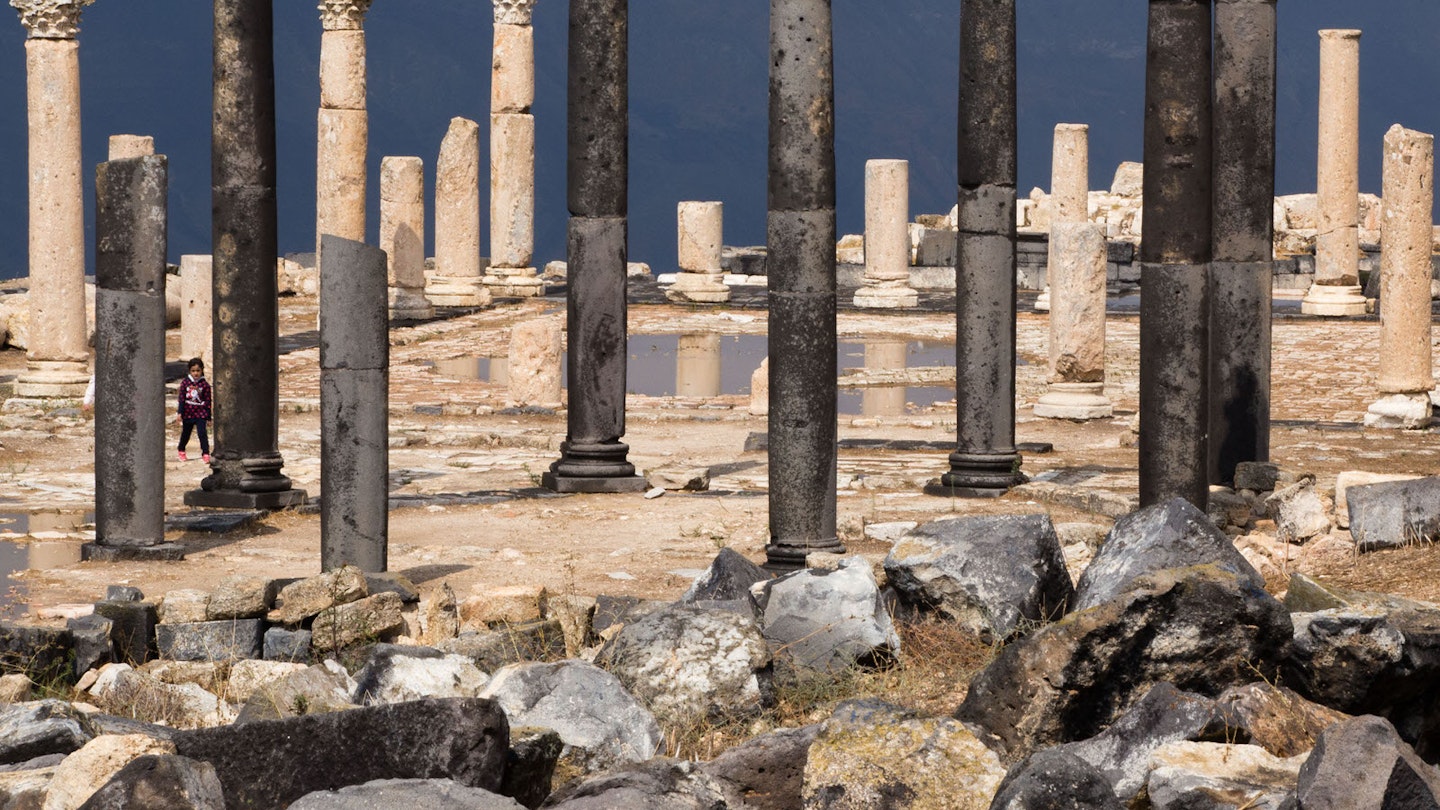Discover Northern and Eastern Jordan’s Hidden Gems
Once you’ve hiked the desert dunes of Wadi Rum, experienced the iconic ruins of Petra, and browsed the vibrant bazaars of Amman, venture into Jordan’s less-explored northern and eastern regions. These areas are known for their windswept temple ruins, crumbling castles, and captivating glimpses into the history that shapes the modern borders of the Middle East. Although these regions might be off today’s tourist track, they lie along ancient caravan routes frequented by travelers for centuries.
Umm Qais Castle
Located in the far north of Jordan overlooking the Golan Heights, Syria, and Israel, the city of Umm Qais was originally known as the Greek city of Gadara and was later conquered by the Romans. Its ruins include the iconic Basilica Terrace, featuring the standing columns of a former Byzantine church that lies at the heart of the settlement. Despite its distance from Amman, Umm Qais sees few visitors, allowing you to explore the ruins or the adjacent archaeological museum in relative solitude. Beyond its archaeological significance, Umm Qais is believed by biblical scholars to be the site where Jesus cast out demons into a herd of pigs, as narrated in Matthew 8:28–34.
Ruins of Jerash
The ancient Greco-Roman city of Gerasa is the only tourist site in northern Jordan that attracts serious visitor numbers. Perched atop a broad hill above the modern town of Jerash, this ancient city flourished primarily during the 1st century AD. Unlike many renowned Roman ruins, visitors can freely navigate the impressive Hippodrome, stroll past the majestic columns of the central Cardo Maximus, and walk through Hadrian’s Arch, just as the emperor did on his visit in 129 AD. The long-abandoned Temple of Artemis and Temple of Zeus add depth to the interactive experience that few ruins can match.
Ruined City of Pella
Competing with Gerasa in age and former grandeur, the ruins of Pella evoke the feeling of a forgotten outpost. Yet, beneath the surface, a vast city lies buried within the dirt of the Jordan Valley. Located less than 30km south of the Sea of Galilee on the historic trade route to Jerash, this atmospheric Greco-Roman city remains a poignant reminder of Jordan’s storied past. Visitors can explore remains of a small amphitheater, a Bronze-Age temple, and excavated shops and homes, highlighting Pella’s role in the Decapolis—a group of ten Roman cities that played a crucial part in the empire’s governance of the Levant region.
Ajloun Castle and Jordan’s Christian Quarter
Perched on a forested hilltop, Ajloun Castle has been a sentinel over northern Jordan since the time of Saladin, serving as a military site into the Ottoman period. Presently, it is a prominent tourist attraction providing insight into the region’s history. Ajloun is notable for its large Christian community within a predominantly Muslim country. In addition to several nearby hiking trails winding through the Ajloun Forest Reserve, religious sites such as Mar Elias—believed to be the birthplace of the prophet Elijah—occasionally welcome pilgrims and religious tourists.
Umm Al Jimal
Translating to “mother of camels” in Arabic, Umm Al Jimal served as a vital caravan stop during the Nabataean era. The site is characterized by its Roman and Byzantine ruins, highlighting its importance as a military garrison. Comprising a sprawling collection of basalt stone structures, some nearly intact while others are in various states of disrepair, the site provides insight into the historical significance of this once-bustling settlement.
Qasr Al Azraq
Constructed by the Romans around 300 AD, Azraq Castle draws modern visitors interested in the legendary Lawrence of Arabia. During the winter of 1917, TE Lawrence utilized this fortress, previously an Ottoman military outpost, as a strategic location during the Great Arab Revolt. While no artifacts remain from Lawrence’s time, the castle’s largely preserved architecture offers a glimpse into the past.
Qusayr Amra
A unique example among Jordan’s desert castles, Qusayr Amra was originally a hunting lodge complex built by the Umayyad ruler Walid I. The 8th-century structure features a bathhouse renowned for its exquisite murals showcasing human forms and contemporary rulers. Notably, the frescoes also include a charming depiction of a seated bear playing a guitar-like instrument.
Getting There
While the main towns in northern and eastern Jordan are accessible through public transportation, remote ruins are not well-served. To visit these spectacular sites, consider hiring a car or engaging a driver from Amman. Allocate a minimum of two days for exploring each region, allowing more time to fully appreciate the smaller attractions sprinkled throughout.





